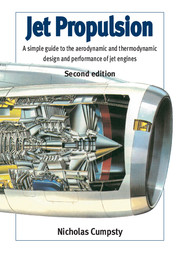 Jet Propulsion
Jet Propulsion Book contents
- Frontmatter
- Contents
- Preface
- Glossary
- Nomenclature
- Part 1 Design of Engines for a New 600-seat Aircraft
- 1 The New Large Aircraft – Requirements and Background
- 2 The Aerodynamics of the Aircraft
- 3 The Creation of Thrust in a Jet Engine
- 4 The Gas Turbine Cycle
- 5 The Principle and Layout of Jet Engines
- 6 Elementary Fluid Mechanics of Compressible Gases
- 7 Selection of Bypass Ratio
- 8 Dynamic Scaling and Dimensional Analysis
- 9 Turbomachinery: Compressors and Turbines
- 10 Overview of the Civil Engine Design
- Part 2 Engine Component Characteristics and Engine Matching
- Part 3 Design of Engines for a New Fighter Aircraft
- Part 4 Return to the Civil Transport Engine
- Appendix: Noise and its Regulation
- Bibliography
- References
- Index
- Design sheets for New Large Civil Aircraft and New Fighter Aircraft
1 - The New Large Aircraft – Requirements and Background
from Part 1 - Design of Engines for a New 600-seat Aircraft
- Frontmatter
- Contents
- Preface
- Glossary
- Nomenclature
- Part 1 Design of Engines for a New 600-seat Aircraft
- 1 The New Large Aircraft – Requirements and Background
- 2 The Aerodynamics of the Aircraft
- 3 The Creation of Thrust in a Jet Engine
- 4 The Gas Turbine Cycle
- 5 The Principle and Layout of Jet Engines
- 6 Elementary Fluid Mechanics of Compressible Gases
- 7 Selection of Bypass Ratio
- 8 Dynamic Scaling and Dimensional Analysis
- 9 Turbomachinery: Compressors and Turbines
- 10 Overview of the Civil Engine Design
- Part 2 Engine Component Characteristics and Engine Matching
- Part 3 Design of Engines for a New Fighter Aircraft
- Part 4 Return to the Civil Transport Engine
- Appendix: Noise and its Regulation
- Bibliography
- References
- Index
- Design sheets for New Large Civil Aircraft and New Fighter Aircraft
Summary
INTRODUCTION
This chapter looks at some of the commercial requirements and background to the proposals to build a new civil airliner capable of carrying about 600 people. The costs and risks of such a project are huge, but the profits might be large too. In explaining the requirements some of the units of measurement used are discussed. Design calculations in a company are likely to assume that the aircraft flies in the International Standard Atmosphere (or something very similar) and this assumption will be adopted throughout this book. The standard atmosphere is introduced and discussed towards the end of the chapter. The chapter ends with brief reference to recent concerns about environmental issues.
SOME COMMERCIAL BACKGROUND
In December 2000 Airbus formally announced the plans to go ahead with a new large aircraft, dubbed the A380, intended in its initial version to carry a full payload (with 555 passengers) for a range of up to 8150 nautical miles. First flight is intended to be in 2004 and entry into service in 2006. There are already plans afoot for heavier versions, carrying more that 555 passengers and for all-freight versions with a larger payload. In December 2000 Airbus Industrie had received enough orders to justify the expected cost of over $10 billion, with an expected breakeven point with a sale of 250 aircraft. They forecast delivery of the 250th aircraft in 2011.
- Type
- Chapter
- Information
- Jet PropulsionA Simple Guide to the Aerodynamic and Thermodynamic Design and Performance of Jet Engines, pp. 3 - 14Publisher: Cambridge University PressPrint publication year: 2003


